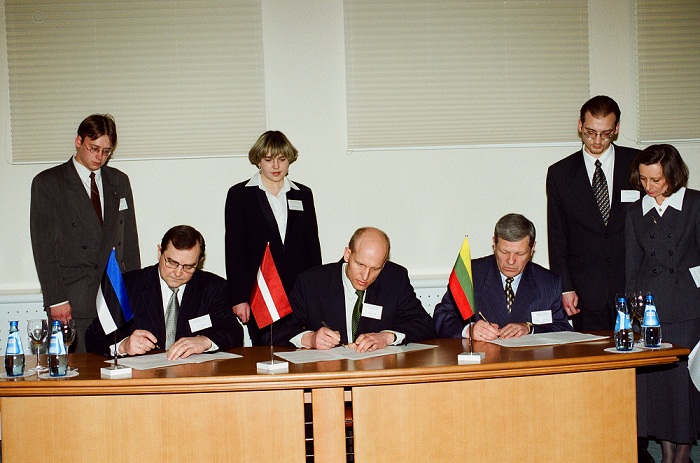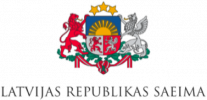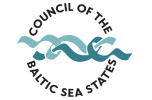Integration
European and transatlantic integration, 1995 - 2004
The period from 1995 to 2004 is one of the most challenge-filled periods for the Baltic regional organisations. Following the withdrawal of the army of the Russian Federation and the signing of the Association Agreements with the European Union, a new phase in the relations between the Baltic States began. The period from 1995 to 2004 can be described by a concept of integration into the European Union and NATO.
 9th Session of the Baltic Assembly in Riga, 5-6 October 1996
9th Session of the Baltic Assembly in Riga, 5-6 October 1996
The European integration and its impact
The European Union has always supported regional cooperation initiatives; that is attested by the fact that during several rounds of enlargement countries that already had close trade and political ties became member states. Although regional cooperation was not specified as a prerequisite for membership in the round of enlargement for which the Baltic States were preparing as candidates, the EU nevertheless urged candidate countries to strengthen regional cooperation. Although initially the Baltic States viewed mutual cooperation as a hindrance to integration into the European Union, they soon realised that many cross-border issues and problems can be resolved by working together at the regional level. However, there is no denying the fact that the Baltic States felt fierce competition on the road to the EU and NATO; that gave grounds for doubting Baltic unity and solidarity because the Baltic States chose the individual EU integration model. At the same time, it can be asserted that this fierce competition served as a driving force for the successful integration of Estonia, Latvia and Lithuania into the European Union and NATO.
EU integration became a driving force for regional cooperation as is confirmed by the agendas of the Baltic Assembly and the Baltic Council of Ministers. Already on 2 December 1995, the Baltic Assembly adopted a decision on the principles that the parliaments and governments of the Baltic States must observe in their mutual relations on the road to European and transatlantic organisations: first, a misfortune or problem in one of the three states should be regarded as a misfortune and concern of all three states; second, a threat posed to one of the three states should be regarded as a threat to all three; third, an achievement of one of the three states should be regarded as an achievement of all three.
Functioning of the Baltic Assembly and the Baltic Council of Minister
The activation of the functioning of the Baltic Assembly and the Baltic Council of Ministers in a range of areas is clearly identifiable in the period from 1995 to 2004, especially regarding harmonisation of Baltic States’ legislation with EU requirements and thus advancing Baltic integration into the European Union and NATO. Cooperation between the Baltic States in respect of integration into NATO was oriented towards setting up a broad partnership in defence. Considering the number of adopted decisions, the areas covered and the content of these decisions, the activities of the Baltic Assembly and the Baltic Council of Ministers during this period were very broad. The Baltic States actively developed cooperation in the areas of defence, education, culture and science, harmonised border-crossing procedures and trade policy, started important infrastructure projects, such as the Via Hanseatica, the Rail Baltica and the Via Baltica, created a customs union and a common economic area, coordinated environmental protection projects, and developed joint measures to combat organised crime and drug trafficking. Even though the Baltic Assembly was heavily criticised for its consultative nature, the evaluation of executive reports on the implementation of Baltic Assembly decisions revealed that approximately 85% of the recommendations issued by the Baltic Assembly were in fact implemented by the Baltic Council of Ministers during this period. Thus, the Baltic Assembly and the Baltic Council of Ministers resolved internal and foreign policy problems of the Baltic States, ensured regular dialogue between the Baltic States and actors in international policy, as well as lobbied for the interests of the Baltic States in the EU and NATO both directly and indirectly.
Partnerships were the Nordic and Benelux countries
The most important actors in international policy with whom the Baltic Assembly and the Baltic Council of Ministers developed close partnerships were the Nordic and Benelux countries. The Baltic Assembly especially strengthened cooperation with the Nordic Council and the Benelux Parliament because the intensification of this cooperation was considered to be an additional resource in integrating the Baltic States into the EU and NATO. By using the Nordic Council, the Nordic Council of Ministers and the Benelux Parliament, both the Nordic and Benelux countries gave political and economic support, promoted the attraction of investments through various projects, and passed on experience regarding the integration process into the EU and NATO. Both the Nordic and the Benelux countries stressed the need to strengthen cooperation with the Baltic States within the framework of regional organisations because that would facilitate the exchange of information, experience and opinions, as well as draw international attention to the Baltic States.

Formation of relations with the Russian Federation
In the period from 1995 to 2004, another issue that was on the agenda of the Baltic Assembly was the formation of relations with the Russian Federation. The first signal which caused Baltic regional organisation representatives to carefully start watching the Russian Federation’s actions regarding the Baltic States was the conference on coexistence of nations and good neighbourly relations held in Vilnius on 5 – 6 September 1997. At this conference, Viktor Chernomyrdin, Prime Minister of the Russian Federation, announced the Russian Federation’s proposals regarding security guarantees for the Baltic States. The presidents of the Baltic countries reacted to this proposal by stressing that the Baltic States had decided to join NATO.
On 24 October 1997, during the signing of the border treaty between the Russian Federation and Lithuania, Boris Yeltsin, President of the Russian Federation, presented new proposals for guaranteeing the security of the Baltic States. On 8 November 1997, the Baltic Assembly reacted to his initiative concerning security guarantees for the Baltic States and measures to strengthen trust in the relations between the Baltic States and Russia by adopting a common Baltic Assembly Declaration which clearly stated support for the official position of the countries and emphasised that the Baltic States regard their security guarantees within the European and transatlantic structures. Another crucial Russian Federation aspect appeared on the agenda of the regional organisations of the Baltic States in May of 1998, when the Baltic Assembly expressed common support for Latvia concerning reproaches made by the Russian Federation.

Baltic Assembly - a defender of interests and forum for exchange of views
During the period from 1995 to 2004, the Baltic Assembly played two important roles as an international organisation – first, it served as a defender of the national interests of Estonia, Latvia and Lithuania; second, it provided a forum for exchange of viewpoints and expressing common positions. The Baltic Assembly supplemented Estonia’s, Latvia’s and Lithuania’s resources for advancing national interests with regard to development and economic stabilisation and their integration into the EU and NATO. Concerns that Baltic regional cooperation may be viewed as an alternative to integration into the EU dissolved. Representative of Estonia, Latvia and Lithuania clearly understood that integration into the EU and NATO and the activities of the Baltic regional organisations are reciprocal, not parallel, processes.
On 29 March 2004 the Baltic States joined the NATO alliance, while on 1 May 2004 they became Member States of the EU. Joining the EU and NATO represented achieving major strategic goals and signalled a new period of development in the development of the Baltic States.
© Photos by Uldis Briedis and Uldis Pāže









